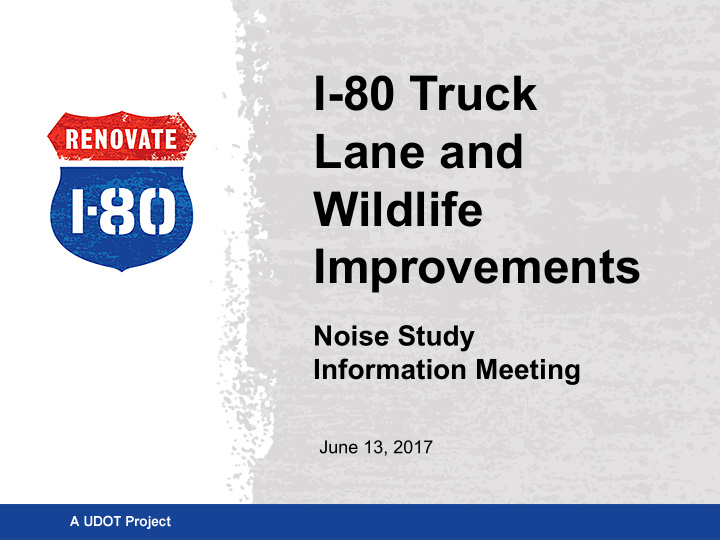



I-80 Truck Lane and Wildlife Improvements Noise Study Information Meeting June 13, 2017
Agenda • Project and environmental analysis overview • UDOT Noise Abatement Policy • What is noise? • I-80 Noise Study process and results • Noise balloting (scheduled for late June) • Open house for questions
Project Overview • New WB truck lane from Jeremy Ranch to Parleys Summit • New asphalt pavement in both directions between Jeremy Ranch and Lambs Canyon • Wildlife fencing between Jeremy Ranch and Parleys Summit • Wildlife crossing near county line
Environmental Analysis Threatened Noise Impacts Waters of the Right-of-Way Cultural and U.S. Resources Noise will increase No impacts Endangered as a result of the Less than associated with No adverse Species/ new truck lane. 1/10 -acre this project. effect to an Wildlife One potential noise of impact to historic rail No impacts. wall will be evaluated wetlands. line on top of Fencing and and balloted. the vertical cut wildlife bridge slope north of will be a benefjt. I-80.
UDOT Noise Abatement Policy • Purpose: Establish a procedure for conducting traffic noise studies, implementing noise abatement measures and coordinating with local municipalities and the public • Noise abatement will be considered for Type I Projects: • Climbing lane functions as a through traffic lane • Consider mitigation that is feasible and reasonable
What is Noise? • Noise is defined as loud, unexpected, or annoying sound • Common Noise Levels • Measure in decibel units converted to approximate human ear conditions=dB(A)
Typical A-Weighted Noise Levels Noise Level Common Outdoor Activities Common Indoor Activities dB(A) — 110 — Rock band Jet fly-over at 1,000 feet — 100 — Gas lawn mower at 3 feet — 90 — Diesel truck at 50 feet at 50 mph Food blender at 3 feet — 80 — Garbage disposal at 3 feet Noisy urban area, daytime Gas lawn mower, 100 feet — 70 — Vacuum cleaner at 10 feet Commercial area Normal speech at 3 feet Heavy traffic at 300 feet — 60 — Large business office Quiet urban daytime — 50 — Dishwasher next room Quiet urban nighttime — 40 — Theater, large conference room (background) Quiet suburban nighttime — 30 — Library Quiet rural nighttime Bedroom at night, concert hall (background) — 20 — Broadcast/recording studio — 10 — Lowest threshold of human hearing — 0 — Lowest threshold of human hearing Source: Caltrans 2013
Noise Study Process • Determine sensitive receptors – noise abatement is only considered where frequent human use occurs and where a lowered noise level would beneficial (Policy) • Develop a noise model using the FHWA TNM 2.5 • Collect field measurements to verify the model • Run the model: – Existing Conditions – Future Conditions
Noise Abatement Criteria (NAC) FHWA UDOT Activity Criteria Criteria Description of Activity Category Leq(h) Leq(h) 2 Lands on which serenity and quiet are of extraordinary 57 56 significance and serve an important public need and where A (Exterior) (Exterior) the preservation of those qualities is essential if the area is to continue to serve its intended purpose 67 66 B Residential (Exterior) (Exterior) Active sports areas, amphitheaters, auditoriums, campgrounds, cemeteries, daycare centers, hospitals, libraries, medical facilities, parks, picnic areas, places of 67 66 C worship, playgrounds, public meeting rooms, public or (Exterior) (Exterior) nonprofit institutional structures, radio studios, recording studios, recreation areas, Section 4(f) sites, schools, television studios, trails and trail crossings Auditoriums, daycare centers, hospitals, libraries, medical 52 51 facilities, places of worship, public meeting rooms, public or D (Interior) (Interior) nonprofit institutional structures, radio studios, recording studios, schools, and television studios 72 71 Hotels, motels, offices, restaurants/bars and other developed E (Exterior) (Exterior) lands, properties or activities not included in A–D or F Agricultural, airports, bus yards, emergency services, industrial, logging, maintenance facilities, manufacturing, F --- --- mining, rail yards, retail facilities, shipyards, utilities (water resources, water treatment, electrical), and warehousing G --- --- Undeveloped lands that are not permitted 1. Hourly A-Weighted Sound Level Decibels (dB(A)) 2. Hourly A-weighted sound level in decibels reflecting a 1 dB(A) “approach” value below 23 CFR 772 values. Source: UDOT Noise Policy
Noise Study Results • Impacts: – 38 Residential properties – 5 Recreational areas • No substantially higher impacts (>10 dB(A)) Outdoor Indoor Increase over Increase over Noise Level Noise Level Alternative Existing Existing dB(A) dB(A) dB(A) dB(A) Min. Max. Min. Max. Min. Max. Min. Max. Existing 49 73 N/A N/A 41 43 N/A N/A (No-Build) Build 50 74 0 2 42 44 1 1
Noise Study Results • One noise barrier investigated – Meets “feasible” and “reasonable” criteria of the Policy • Provides abatement to 24 residences and two recreational areas • 3,200 feet long • 18 feet high • Cost: $1,152,000 • Recommended for balloting
Noise Balloting • 22 benefitted receptors • Process: – Ballots are sent to: What is a benefitted • All benefited receptors receptor? • Receptors that border or that are directly adjacent to the A noise sensitive end of a proposed noise wall receptor that receives a that are not, by definition, benefited by the wall are noise reduction of at balloted. least 5 dB(A) – 75% of ballots mailed must be returned. – Walls recommended if 75% of votes returned are in favor • Schedule: Ballot late June
Recommend
More recommend